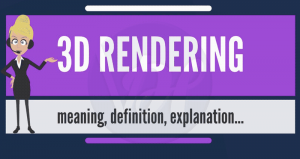Contents List
The rendering momentous has a great personification in the augmentation of computer graphics. It is a process to create a 3-D and 2-D image from a model by an application programme. Rendering is mostly used in animated movies, simulators, video games, TV special effects, and visualization.
What is Rendering
Rendering is stated as the most complicated or convoluted and abstruse facet of 3D production, but it can be presumed quite easily in the ambiance of a comparison. It is much more like a film photographer who flourishes and prints his photos before it gets advertised, computer graphics professionals are loaded a similar exigency. The term rendering means the calculations done by the 3D software packages render engine for translating the scene mathematical calculation to a final 2D image.
Variety of rendering
There are two chief types of rendering, and the chief differentiator is the speed of computing and finalizing the images
Real-Time Rendering:
Real-time rendering is used more extensively for gaming and graphics purpose wherein the images are computed from 3D info at an unbelievable quick speed.
Offline or Pre Rendering:
The rendering which is used in conditions where speed is of less issue and reckoning is classically performed by not using hardware which are graphically dedicated but using the multi-core CPU’s.
Also Read:- What Is a WAN? | Wide Area Network Definition
Rendering Techniques
In total three dominant computational techniques are used in rendering, and each one of these techniques carry their own merits and demerits which turns all of them feasible options that could be considered in specific situations.
Scanline (Rasterization):
This technique is taken into consideration when speed is prerequisite which enables the choice of taking the technique as a choice for real-time rendering and interactive graphic. Scanline technique can enable to achieve the users a speed of sixty frames per second (60 FPS) or better on a high-end graphics card.
Raytracing:
For every pixel in the scene in raytracing technique, one or more ray of lights is pursued right from the camera to the 3D object. Each pixel’s color is mathematically computed. Raytracing is proficient greater realness in the photo.
Also Read:- What is Netflix Roulette? How Does it Works?
Features of Rendering
Speed Matters:
To make the motion appear to fluid a minimum of eighteen to twenty frames per second which must be rendered to the screen. If the speed equals/accounts less than this which will make the action appear choppy
Interactivity:
Predicting exactly the player’s interaction with the game environment, pictures/images must be rendered in real-time as the action starts or in other words as soon as the action unfolds.
The methods:
Dedicated graphics (GPU’s) hardware has improved Real-Time rendering outstandingly and by pre-compiling maximum information up to the maximum extent. Game environment’s lighting info is pre-computed and baked direct in the environment’s files of texture to improve render speed.
Radiosity:
Radiosity is completely different from raytracing as it is calculated in camera independence which is surface oriented to some extent pixel-by-pixel. The principal feature of radiosity is to more factually prevaricates surface color by auditing(accounting) for indirect bouncing of diffused light. Actually radiosity and raytracing are commonly used in conjunction with each other utilizing the benefits of each system to attain outstanding levels of photorealism.
Also Read:- What is a DNS Server and How Does it Work?
The Two Most Common Render Engines
Mental Ray:
The mental ray comes packaged with Autodesk Maya. Mental ray js incredibly fast, versatile and most probably the best renderer for character images which requires surface scattering. It uses the combination radiosity and raytracing.
V-Ray:
The V-Ray is most commonly utilized in association with 3D Max – together this combination is what exactly what it is built for architectural visualization and environment rendering. Major benefits of V-Ray over the competitor are its lighting tools and extensive materials of arch-viz.